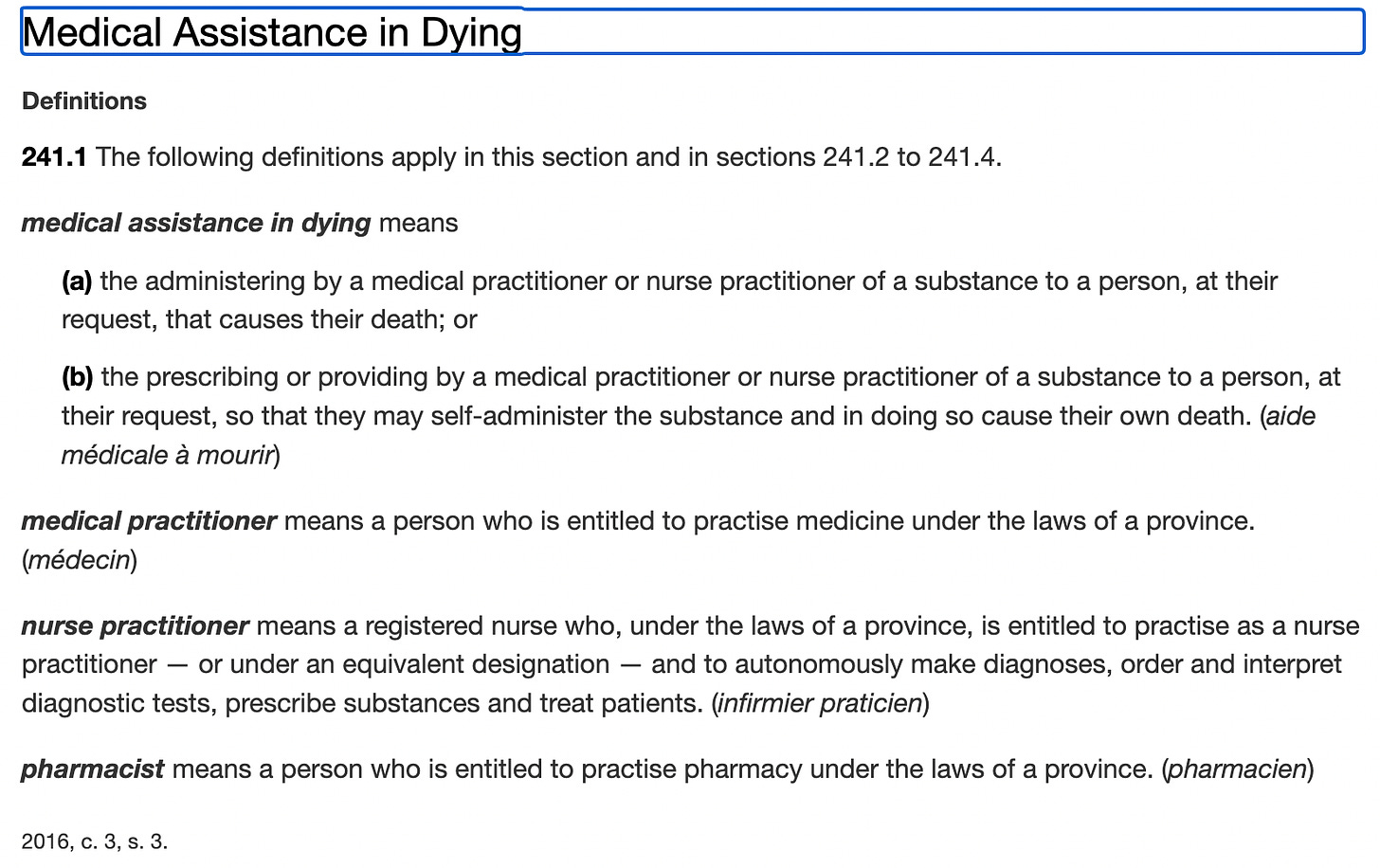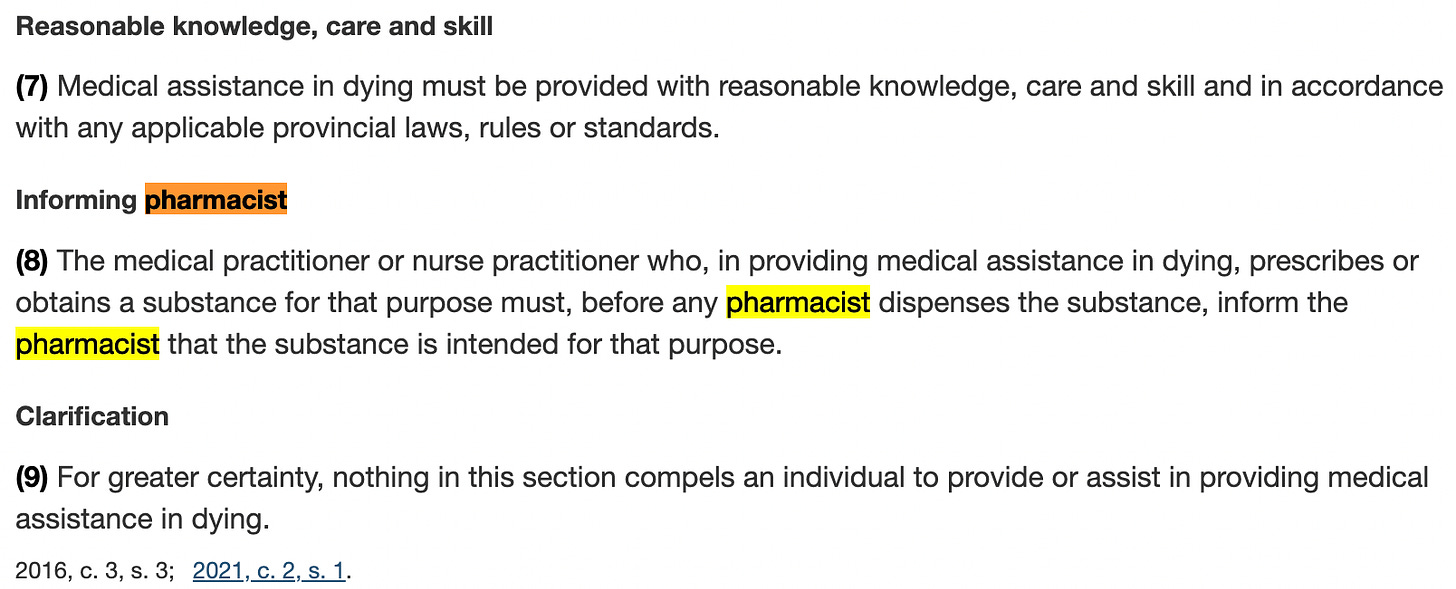Jessica Rose | 30 Aug 2022
Government-assisted sui–cide is being normalized in Canada
Be warned: the Angry Cop in the video posted below does not express himself coyly, and does not sugarcoat the details of this story. This is precisely why I like the video that he made. Be prepared for in-your-face charades if you press play.
Government-assisted suicide is being normalized in Canada.
Angry Cop claims that he was prompted to look up Medical Assistance in Dying Canada. He did. I did. You should too.
On March 17, 2021, the Government of Canada announced that changes to Canada’s medical assistance in dying (MAID) law are officially in force. The new law includes changes to eligibility, procedural safeguards, and the framework for the federal government’s data collection and reporting regime.
Changes to ‘safeguards’? You mean, removing liability when your loved ones are not only encouraged to kill themselves, but helped in doing so?
I want to point out the most horrific, and I do mean horrific, points in this Medical Assistance in Dying Canada document, starting with something I found very disturbing. I mean, in an ominous way.
Disturbing point #1:
Q: Why is ‘pharmacist’ defined explicitly?


They define 3 words in the beginning of the document: 1. medical practitioner, 2. nurse practitioner and 3. pharmacist. When I first read this, I did a double take and had to re-read 241.1(a) again to make sure that this document does not give permission without liability to pharmacists to help people kill themselves. It does not include pharmacists at the current time. But I have to wonder, will they amend this document include this option? The only other mention of the word ‘pharmacist’ in this document is at the very end where they redefine ‘Informing pharmacist’, which is a subset of ‘pharmacists’ entitled to dole out the kill drugs knowingly to medical and nurse practitioners who intend to use these drugs to help suicide a fellow Canadian citizen.
Update/correction: information from an MD (August 30, 2022)
#1) It appears that “informing pharmacist” is not a subset of pharmacists, but actually the requirement for the doctor or NP to “inform the pharmacist” filling the prescription of the purpose of the medication. This is common or standard practice outside of suicide (i.e. prescriptions require a diagnosis/usage). This just means you can’t ask a pharmacist to fill something to kill someone without telling them (i.e. blood pressure medication for treating HTN; morphine for the purpose of suicide versus morphine to treat pain). This is a requirement on the doctor/NP, not about the pharmacist; and is meant to protect the pharmacist (for now, unless the wording changes) from dispensing medication for a purpose that they don’t support (i.e. suicide).
Disturbing point #2:
You only have to be 18! THAT’S A TEENAGER, DOUCHEBAGS. Also, they must be ‘capable of making decisions with respect to their health’. Well, you know, except for when it comes to making decisions about what they get injected with or not!
Disturbing point #3: (I literally had to read this 5 times to make sure it actually says what I understood it to say.)
This document, in writing (legally binding), says that if a person objects at the last minute using ‘sounds’ then it doesn’t count as an objection and the killing can proceed.



Section 3 is about safeguards – the conditions under which a person isn’t killed by a ‘whoopsie’. You know like, ‘Whoopsie, that person actually didn’t want to die and I helped them kill themselves anyway’. Death is permanent, right?
For the purposes of subsection (3): ‘Safeguards’, the medical practitioner or nurse practitioner may administer a substance to a person to cause their death without meeting the requirement set out in paragraph 3(h)
What is the requirement of paragraph 3(h) you ask?
Safeguards — natural death foreseeable
(3) Subject to subsection (3.2) – which refers to the ‘Final consent – waiver’ – before a medical practitioner or nurse practitioner provides medical assistance in dying to a person whose natural death is reasonably foreseeable, taking into account all of their medical circumstances, without a prognosis necessarily having been made as to the specific length of time that they have remaining, the medical practitioner or nurse practitioner must (h) immediately before providing the medical assistance in dying, give the person an opportunity to withdraw their request and ensure that the person gives express consent to receive medical assistance in dying.
Here’s what the ‘Final consent – waiver’ states:
Final consent – waiver
(3.2) For the purposes of subsection (3), the medical practitioner or nurse practitioner may administer a substance to a person to cause their death without meeting the requirement set out in paragraph (3)(h) if (c) the person does not demonstrate, by words, sounds or gestures, refusal to have the substance administered or resistance to its administration.
Just to summarize, this means that the doctor can kill the person without asking them at the minute if they changed their mind if the person does not ‘indicate’ a refusal to die. BUT, for greater certainty:
For greater certainty
(3.3) For greater certainty, involuntary words, sounds or gestures made in response to contact do not constitute a demonstration of refusal or resistance for the purposes of paragraph (3.2)(c).
Wait what? Am I getting this right? I am bewildered by the construct of legal documents, but I thought is necessary to try to find my way through these weeds because it seems to me, that they have described that if a person objects at the last minute, then they cannot be killed but at the same time, an objection is not defined clearly. In fact, they appear to over-write the words ‘involuntary words’, ‘sounds’ or ‘gestures’ in the ‘For greater certainty’ subsection, and ambiguously use the words ‘in response to contact’.
What I understand this to mean, is that if person has been ‘convinced’ that it’s better to kill themselves with assistance, and they object at that last minute (when they’re strapped onto a bed and on sedatives) by uttering groans (the administration of sedatives would be contact, non?), then this does not count as a demonstration of refusal and the person who was decided that they wanted to live, was killed anyway.
Update/correction: information from an MD (August 30, 2022)
#2) The section 3.2 appears to be giving a series of exclusion criteria … the practitioner may only move forward IF … the person does not demonstrate refusal by words, sounds, or gestures.
– So I believe the meaning of this is the opposite of what you conveyed.
I have read and watched horror stories about the use of kill drug mi da-zol am in nursing homes in the UK and I sure that these stories are verifiable by nurses and home care workers. I mention this because it seems to me, that although my interpretation above seems like an insane conclusion, it lines up with the people’s stories around the world.
If there are lawyers reading this, help me to understand if I got this right.


